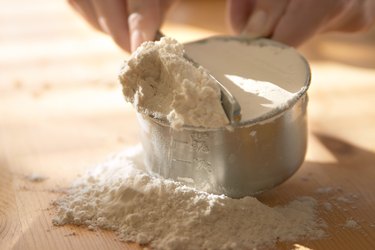
Opening a bag of flour and seeing things moving inside might be enough to put you off gluten for years. Grain mites, also sometimes called flour mites, are minuscule creatures that can hitch a ride into your pantry in many kinds of packaged grains. Getting rid of grain mites is primarily about getting rid of the infested grains, but there are some other steps you'll want to take to make sure the problem is truly resolved.
What Are Grain Mites?
Video of the Day
Grain mites (Acarus siro Linnaeus) can infest many kinds of grains, feeding primarily on the germ. They're so small that individual mites can't easily be seen with the naked eye, and they're pale and whitish, making them especially difficult to spot in a package of flour. (If you see little brown bugs in the kitchen, especially around flour or other grains, they could be sawtoothed grain beetles or granary weevils, but their color means they're not grain mites.) However, grain mites reproduce so quickly, a package of infested grains might actually look alive with movement.
Video of the Day
Other than seeing the active mites in a container of flour or other grains, there are a few indicators of a grain mite infestation. A kind of brown dust is created when mites die or shed, which you might notice accumulating under a bag of infested grains or in the corners of a cabinet where grain mites are living. An unpleasant or minty odor may also be detectable.
Getting Rid of Grain Mites
Obviously, you don't want to consume any food that's contaminated with grain mites. Throw away any infested products. Consider tossing any other food that has been in close contact with the package since you can't know whether the mites have spread.
Once the mite-infested foods are gone, turn your attention to cleaning up the area where they were stored. First, use your vacuum with its crevice tool attached or a handheld vacuum cleaner to suck up any tiny mites or dust particles that might be lingering in the crevices of your shelf. Immediately empty the vacuum into a trash bag and tie it closed to contain any mites you collected. Next, use a microfiber cleaning cloth and hot, soapy water to clean the shelf or pantry. Follow with a clean, wet cloth to remove any soap residue.
Removing the affected food and cleaning the storage area is generally sufficient for dealing with grain mites in your home. Don't reach for potent cleaners or pesticides. Like dealing with any infestation in your kitchen — killing pantry moths, for example, or getting rid of weevils — using natural methods is preferable to using chemical insecticides.
Preventing Grain Mites
There's not a lot you can do to keep grain mites out of your kitchen since you can't know if the bag of flour you just bought is hiding any mites inside. Your best bet for preventing grain mites is to identify future issues quickly before they become infestations.
When you bring home flour and other grains, consider moving them from their original packaging and into containers with airtight lids. If you buy a product that's infested with grain mites, you're more likely to discover the problem right away when you transfer it to the airtight container. Storing grains in an airtight container may also protect other pantry items from being contaminated if mites do appear again.
Grain mites flourish in humid conditions, so controlling the humidity in your kitchen (or wherever you store grains) may also be useful for preventing future outbreaks.